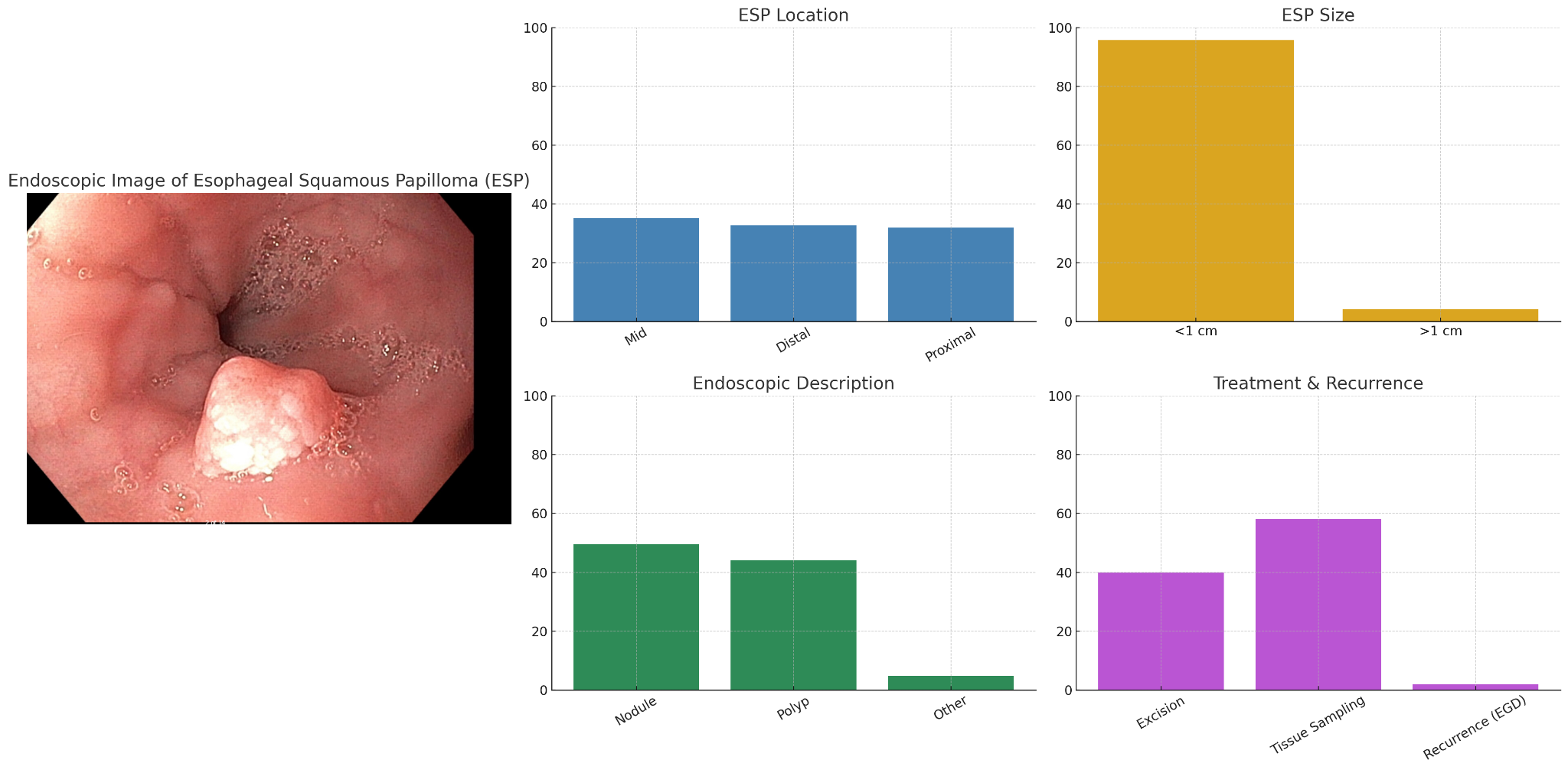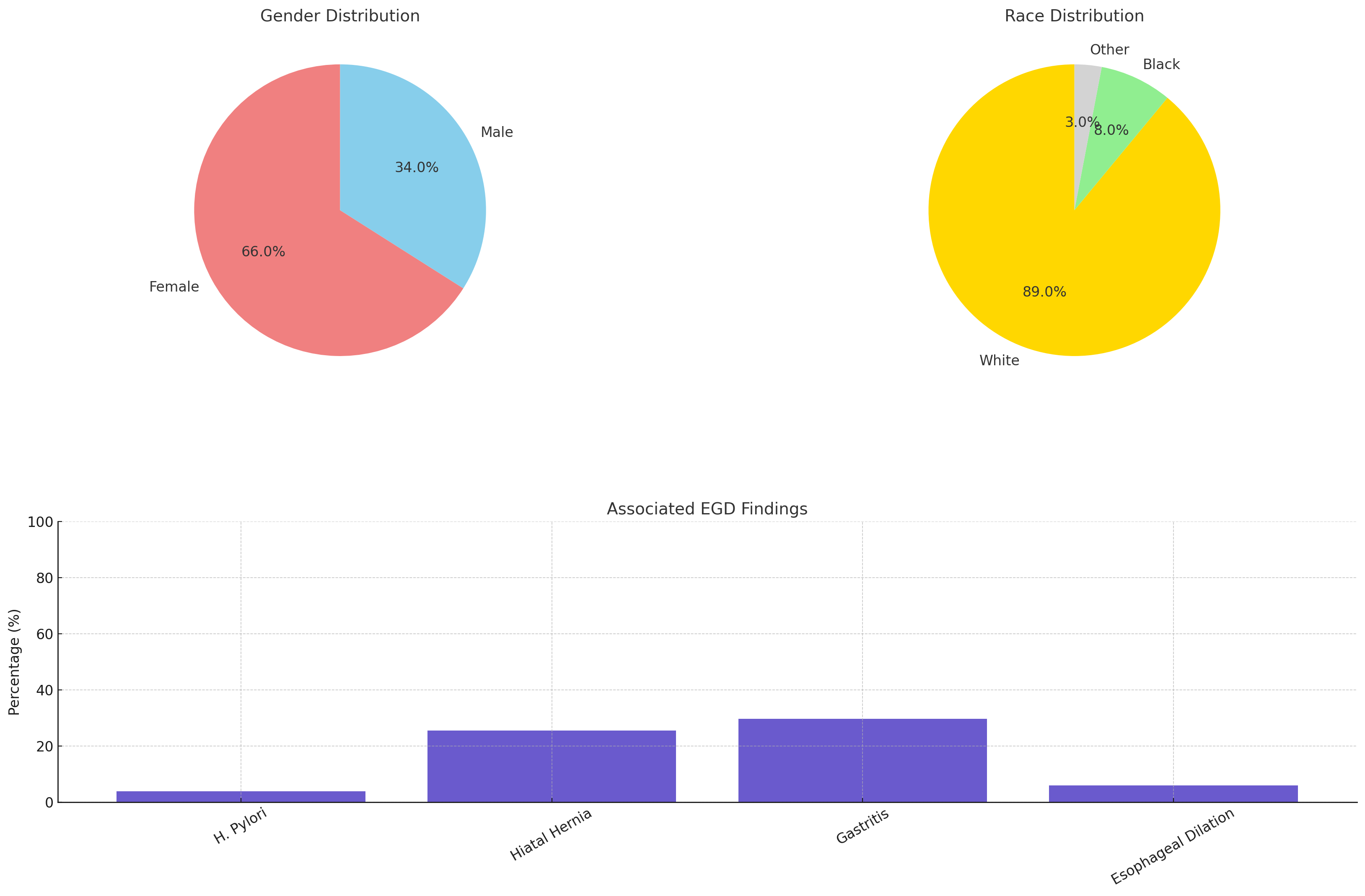Tuesday Poster Session
Category: Esophagus
P4952 - Prevalence, Characteristics, and HPV Testing Outcomes of Esophageal Squamous Papillomas: A Retrospective Study of the Largest Single-Center Cohort
Tuesday, October 28, 2025
10:30 AM - 4:00 PM PDT
Location: Exhibit Hall

Waqqas Haroon, MD (he/him/his)
Cleveland Clinic Foundation
Cleveland Heights, OH
Presenting Author(s)
Waqqas Haroon, MD1, Ahmed Nadeem, MD2, Zain Zain bassato, MD2, Clifton Fulmer, MD2, Ari Garber, MD2
1Cleveland Clinic Foundation, Cleveland Heights, OH; 2Cleveland Clinic Foundation, Cleveland, OH
Introduction: Esophageal squamous papillomas (ESPs) are rare, benign tumors typically detected incidentally on endoscopy. While their incidence has risen, their pathogenesis and malignant potential remain unclear. ESPs have been associated with chronic mucosal irritation and HPV infection, but reported HPV detection rates vary widely (0–85.7%) due to small sample sizes and inconsistent testing methods, many of which do not assess oncogenic HPV activity. A better understanding of ESPs is needed to guide management. We present the largest study to date evaluating the clinical characteristics of ESPs and the utility of HPV testing, including RNA-based assays, at a tertiary academic center.
Methods: Single-center retrospective cohort study of patients with ESPs was performed. All patients, age >18 years, presenting between January 2018 and July 2023, diagnosed with ESPs and sufficient tissue samples were included. Slides were reviewed by pathologists. RNA-based chromogenic in situ hybridization (ISH) studies for low- and high-risk HPV subtypes were performed. Extensive Chart review for demographic information, clinical history (including tobacco use, alcohol consumption, and prior gastrointestinal malignancy), and HPV vaccination status were recorded.
Results: Of the total 184 ESP cases, None demonstrated squamous dysplasia or invasive carcinoma (0%). All samples were negative for low- and high-risk HPV on RNA-based testing.The cohort was predominantly female at 66%, median age of 53 years (range 19–87), and 89% White, non-Hispanic. Tobacco and chronic alcohol use were reported in 31% and 23%, respectively. Endoscopically, 98% lesions appeared as nodules or polyps. Nearly all lesions measured under 1 cm (98%). Lesions were most commonly in the mid-esophagus (46%), followed by distal (32%) and proximal (22%). 40% underwent complete excision and 58% tissue sampling.33 had a repeat EGD, of those 2% had ESP recurrence.
Discussion: This study represents the largest single-center review of esophageal squamous papillomas to date, no cases of dysplasia or carcinoma were identified, and all specimens tested negative for oncogenically active low/high-risk HPV using highly sensitive RNA ISH. Suggesting that ESPs are not precursor lesions to squamous cell carcinoma and their pathogenesis is unrelated to an HPV infection. Further studies are needed to determine standardized management guidelines regarding ESPs. Our data support that endoscopic excision is typically curative for these incidental squamous proliferations.

Figure: Demographic and associated endoscopic findings of patients with esophageal squamous papillomas. The majority of patients were female and White. The bar graphs represent associated lesions found during endoscopic evaluation which includes hiatal hernia, evidence of gastritis, previous endoscopic dilation, and pathological evidence of H. pylori.

Figure: Endoscopic image and clinical characteristics of esophageal squamous papillomas (ESPs). Most lesions were <1 cm, located in the mid esophagus, and appeared as nodules or polyps. The majority underwent excision or tissue sampling, with a low recurrence rate on follow-up EGD.
Disclosures:
Waqqas Haroon indicated no relevant financial relationships.
Ahmed Nadeem indicated no relevant financial relationships.
Zain Zain bassato indicated no relevant financial relationships.
Clifton Fulmer indicated no relevant financial relationships.
Ari Garber indicated no relevant financial relationships.
Waqqas Haroon, MD1, Ahmed Nadeem, MD2, Zain Zain bassato, MD2, Clifton Fulmer, MD2, Ari Garber, MD2. P4952 - Prevalence, Characteristics, and HPV Testing Outcomes of Esophageal Squamous Papillomas: A Retrospective Study of the Largest Single-Center Cohort, ACG 2025 Annual Scientific Meeting Abstracts. Phoenix, AZ: American College of Gastroenterology.
1Cleveland Clinic Foundation, Cleveland Heights, OH; 2Cleveland Clinic Foundation, Cleveland, OH
Introduction: Esophageal squamous papillomas (ESPs) are rare, benign tumors typically detected incidentally on endoscopy. While their incidence has risen, their pathogenesis and malignant potential remain unclear. ESPs have been associated with chronic mucosal irritation and HPV infection, but reported HPV detection rates vary widely (0–85.7%) due to small sample sizes and inconsistent testing methods, many of which do not assess oncogenic HPV activity. A better understanding of ESPs is needed to guide management. We present the largest study to date evaluating the clinical characteristics of ESPs and the utility of HPV testing, including RNA-based assays, at a tertiary academic center.
Methods: Single-center retrospective cohort study of patients with ESPs was performed. All patients, age >18 years, presenting between January 2018 and July 2023, diagnosed with ESPs and sufficient tissue samples were included. Slides were reviewed by pathologists. RNA-based chromogenic in situ hybridization (ISH) studies for low- and high-risk HPV subtypes were performed. Extensive Chart review for demographic information, clinical history (including tobacco use, alcohol consumption, and prior gastrointestinal malignancy), and HPV vaccination status were recorded.
Results: Of the total 184 ESP cases, None demonstrated squamous dysplasia or invasive carcinoma (0%). All samples were negative for low- and high-risk HPV on RNA-based testing.The cohort was predominantly female at 66%, median age of 53 years (range 19–87), and 89% White, non-Hispanic. Tobacco and chronic alcohol use were reported in 31% and 23%, respectively. Endoscopically, 98% lesions appeared as nodules or polyps. Nearly all lesions measured under 1 cm (98%). Lesions were most commonly in the mid-esophagus (46%), followed by distal (32%) and proximal (22%). 40% underwent complete excision and 58% tissue sampling.33 had a repeat EGD, of those 2% had ESP recurrence.
Discussion: This study represents the largest single-center review of esophageal squamous papillomas to date, no cases of dysplasia or carcinoma were identified, and all specimens tested negative for oncogenically active low/high-risk HPV using highly sensitive RNA ISH. Suggesting that ESPs are not precursor lesions to squamous cell carcinoma and their pathogenesis is unrelated to an HPV infection. Further studies are needed to determine standardized management guidelines regarding ESPs. Our data support that endoscopic excision is typically curative for these incidental squamous proliferations.

Figure: Demographic and associated endoscopic findings of patients with esophageal squamous papillomas. The majority of patients were female and White. The bar graphs represent associated lesions found during endoscopic evaluation which includes hiatal hernia, evidence of gastritis, previous endoscopic dilation, and pathological evidence of H. pylori.

Figure: Endoscopic image and clinical characteristics of esophageal squamous papillomas (ESPs). Most lesions were <1 cm, located in the mid esophagus, and appeared as nodules or polyps. The majority underwent excision or tissue sampling, with a low recurrence rate on follow-up EGD.
Disclosures:
Waqqas Haroon indicated no relevant financial relationships.
Ahmed Nadeem indicated no relevant financial relationships.
Zain Zain bassato indicated no relevant financial relationships.
Clifton Fulmer indicated no relevant financial relationships.
Ari Garber indicated no relevant financial relationships.
Waqqas Haroon, MD1, Ahmed Nadeem, MD2, Zain Zain bassato, MD2, Clifton Fulmer, MD2, Ari Garber, MD2. P4952 - Prevalence, Characteristics, and HPV Testing Outcomes of Esophageal Squamous Papillomas: A Retrospective Study of the Largest Single-Center Cohort, ACG 2025 Annual Scientific Meeting Abstracts. Phoenix, AZ: American College of Gastroenterology.

